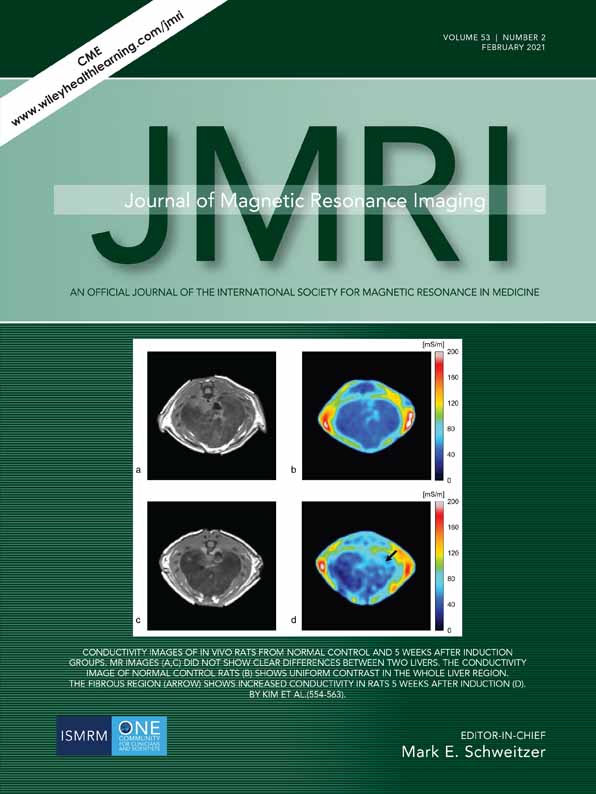Associations Between Carotid Plaque Characteristics and Improvement of Cerebral Blood Perfusion in Patients With Moderate to Severe Carotid Stenosis Undergoing Carotid Endarterectomy
Dr. Huishu Yuan and Dr. Tao Wang are co-corresponding authors and have equally contributed to this study.
Contract grant sponsor: Beijing Natural Science Foundation; Contract grant number: 7192219; Contract grant sponsor: Peking University Third Hospital; Contract grant number: BYSY2015013; Contract grant sponsor: National Natural Science Foundation of China; Contract grant number: 81771825; Contract grant sponsor: Ministry of Science and Technology of China; Contract grant number: 2017YFC1307904.
Abstract
Background
The relationship between plaque characteristics and their predictive value for perioperative cerebral blood flow (CBF) are unknown.
Purpose
To investigate the relationship between carotid plaque characteristics and perioperative CBF utilizing MRI.
Study Type
Prospective.
Population
In all, 131 patients with carotid moderate-to-severe stenosis referred for carotid endarterectomy (CEA).
Field Strength/Sequence
3T, black-blood T1- and T2-weighted, 3D time-of-flight, and simultaneous noncontrast angiography intraplaque hemorrhage.
Assessment
The relative CBF (rCBF = CBFindex-hemisphere/CBFcontralateral-hemisphere) and the CBF difference ratio (DRCBF = [CBFpost-CEA – CBFpre-CEA]/CBFpre-CEA) in the middle cerebral artery territory were measured. The pre- and post-CEA CTP data were used as the assessment standard for CBF change. Carotid lipid-rich necrotic core (LRNC), intraplaque hemorrhage, calcification, fibrous cap rupture, maximum wall thickness, normalized wall index (NWI), and stenosis were determined.
Statistical Tests
Pearson or Spearman correlation, Mann–Whitney U-test, and linear regression.
Results
Patients with LRNC had higher rCBFpre-CEA than those without (1.0 ± 0.1 vs. 0.9 ± 0.1, P < 0.05). NWI was weakly correlated with rCBFpre-CEA (r = −0.213, P < 0.05) and DRCBF (r = 0.185, P < 0.05) and marginally correlated with rCBFpost-CEA (r = 0.166, P = 0.057). LRNC was weakly correlated with rCBFpre-CEA (r = 0.179, P < 0.05). NWI was associated with rCBFpre-CEA (β = −0.035; 95% confidence interval [CI] [−0.064, −0.006]; P < 0.05), rCBFpost-CEA (β = 0.042; 95% CI [0.002, 0.081]; P < 0.05) and DRCBF (β = 0.105; 95% CI [0.026, 0.185]; P < 0.05). After adjusting for confounding factors, associations of NWI with rCBFpost-CEA (β = 0.059; 95% CI [0.016, 0.103]; P < 0.05) and DRCBF (β = 0.110; 95% CI [0.021, 0.199]; P < 0.05) remained statistically significant, while the association between NWI and rCBFpre-CEA was no longer significant (β = −0.026; 95% CI [−0.058, 0.006]; P = 0.112).The associations of LRNC with rCBFpre-CEA (β = 0.057; 95% CI [−0.0006, 0.114]; P = 0.052) and DRCBF (β = −0.157; 95% CI [−0.314, 0.001]; P = 0.051) were close to statistical significance. After adjusting for confounding factors, these associations were statistically significant (of LRNC vs. rCBFpre-CEA: β = 0.060; 95% CI [0.003, 0.118]; P < 0.05; LRNC vs. DRCBF: β = −0.205; 95% CI [−0.375, −0.036]; P < 0.05).
Data Conclusion
Carotid plaque burden and components, particularly LRNC, might be effective indicators for CBF change following CEA.
Level of Evidence 1
Technical Efficacy Stage 5




